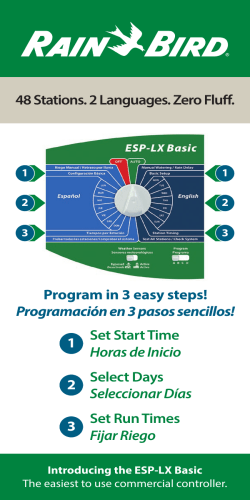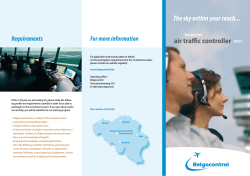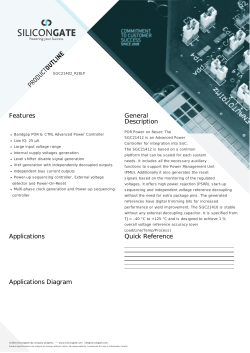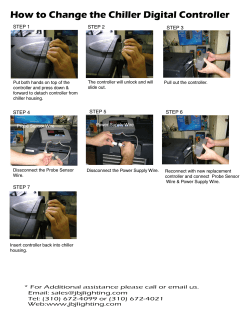
ASP.NET MVC 5 APPLICATION LIFECYCLE â HIGH
ASP.NET MVC 5 APPLICATION LIFECYCLE – HIGH-LEVEL VIEW HttpApplication Processing Pipeline HTTP Request This document shows the lifecycle of every ASP.NET MVC application, beginning from receiving the HTTP request from the client to sending the HTTP response back to the client. It is designed both as an education tool for those who are new to ASP.NET MVC and also as a reference for those who need to drill into specific aspects of the application. HttpApplication Processing Pipeline Controller Creation Routing Authentication and Authorization MvcHandler Model Binding HTTP Response Action Method Invocation Result Execution (View, etc.) Action Invocation (with Filters) ASP.NET MVC 5 APPLICATION LIFECYCLE – DETAIL VIEW HttpApplication Processing Pipeline HTTP Request Tasks to perform: Common tasks such as register routes, bundles, and filters Advance tasks such as set custom controller factory Application_Start (in Global.asax.cs) HttpApplication.Init Override to subscribe to HttpApplication events HttpApplication Processing Pipeline IHttpModule.Init The diagram shows relevant HttpApplication stages to help you understand where MVC integrates into the ASP.NET application lifecycle. In addition, for the overridable methods on the Controller object that are part the MVC lifecycle, the diagram identifies when these methods are invoked in the processing pipeline and why you might want to override them. You may or may not have the need to override any one method, but It is important for you to understand their role in the application life cycle so that you can write code at the appropriate life cycle stage for the effect you intend. Called by the MvcHandler to create the named controller. By default, DefaultControllerFactory is used. To register a custom IControllerFactory, use ControllerBuilder.Current.SetDefaultControllerFactory in Application_Start (in Global.asax.cs) <Named>Controller.ctor HttpApplication.PostResolveRequestCache Override to perform processing before anything is done on the controller Controller.BeginExecute UrlRoutingModule.PostResolveRequestCache Override to perform custom initialization before ControllerBase.Initialize sets Controller.ControllerContext with the encapsulated route data. Controller.Initialize Match request to defined route Controller.BeginExecuteCore If(AuthenticationContext.Result==null) HTTP Response HttpApplication.BeginProcessRequest MvcHandler executes the controller action Color Legend HttpApplication.EndProcessRequest HttpApplication Routing Controller Authentication Filters Authorization Filters Authentication Challenges Action Execution true If(AuthenticationContext.Result==null) Controller.CreateTempDataProvider Override to use a custom TempData provider. SessionStateTempDataProvider is used by default. Controller.CreateActionInvoker Override to use a custom action invoker. AsyncControllerActionInvoker is used by default. <IAuthenticationFilter2>.OnAuthentication If(AuthenticationContext.Result==null) HttpApplication.BeginProcessRequest Execute action method with action filters (IActionFilter) false ... End Use IAuthenticationFilter to authenticate a user action toward the intended resources. Authentication filters execute in order until one of the filters returns a non-null result. false Invoke authorization filters (IAuthorizationFilter) true Invoke authorization filters (IAuthorizationFilter) If(AuthorizationContext.Result==null) false true Start false Controller.OnAuthorization true Invoke authentication challenges (IAuthenticationFilter) Perform model binding on parameters If(AuthorizationContext.Result==null) false true <IAuthorizationFilter1>.OnAuthorization Invoke action with action filters (IActionFilter) If(AuthorizationContext.Result==null) Controller.EndExecute false true <IAuthorizationFilter2>.OnAuthorization Controller.EndExecuteCore Invoke authentication challenges (IAuthenticationFilter) If(AuthorizationContext.Result==null) Execute result Execute result with result filters (IResultFilter) false true ... End Controller.Dispose Result Execution false true If(AuthenticationChallengeContext.Result ==null) HttpApplication.EndProcessRequest Controller.OnAuthentication Invoke authentication filters (IAuthenticationFilter) Store the encapsulated route data (at HttpApplication.Context.Request .RequestContext) HttpApplication.BeginProcessRequest Start <IAuthenticationFilter1>.OnAuthentication IControllerFactory.CreateController Retrieve MvcHandler as the HttpHandler for the request (stored at HttpApplication.Context.Handler) Invoke authentication filters (IAuthenticationFilter) Use IAuthorizationFilters to authorize a user action toward the intended resources. Authorization filters execute in order until one of the filters returns a non-null result. Execute results with result filters (IResultFilter) Invoke authentication challenges (IAuthenticationFilter) Start Controller.OnActionExecuting <ActionFilter1>.OnActionExecuting <ActionFilter2>.OnActionExecuting ... <Named>Controller.<ActionAsync> Controller implements IActionFilter (by inheriting ActionFilterAttribute). OnActionExecuting methods are executed in order before the action method itself. Controller.OnResultExecuting <ResultFilter1>.OnResultExecuting <ResultFilter2>.OnResultExecuting ... Asynchronous action methods (modified with the async keyword and returns Task<T>) are executed in HttpApplication.BeginProcessRequest Invoke action results (ActionResult.ExecuteResult) View, PartialView HttpApplication.EndProcessRequest Controller.EndExecute Controller.EndExecuteCore <Named>Controller.<Action> ... <ActionFilter2>.OnActionExecuted <ActionFilter1>.OnActionExecuted Controller.OnActionExecuted Called in HttpApplication.EndProcessRequest to end the controller execution. For asynchronous action methods, this portion of the pipeline may be invoked in a different worker thread. Synchronous action methods (not modified with the async keyword) are executed in HttpApplication.EndProcessRequest OnActionExecuted methods are executed in reverse order after the action method itself. Find view from view engines (RazorView, etc.) Render view Other ActionResult types Controller implements IResultFilter (by inheriting ActionFilterAttribute). OnResultExecuting methods are executed in order before the result is executed. Controller.OnAuthenticationChallenge <IAuthenticationFilter1>.OnAuthenticationChallenge After authentication challenges are executed as a result of failed authentication or failed authorization, the result is executed immediately without any result filters. <IAuthenticationFilter2>.OnAuthenticationChallenge ... End Write to HTTP response ... <ResultFilter2>.OnResultExecuted <ResultFilter1>.OnResultExecuted Controller.OnResultExecuted OnResultExecuted methods are executed in reverse order after the result is executed Authentication challenges are invoked whenever authentication or authorization filters return a result to indicate failure. They are also invoked after the action method executes in case the authentication scheme requires it, such as for server authentication to the client. Use OnAuthenticationChallenge to create the ActionResult you intend to send to the client when authentication challenges occur. When authentication challenges are invoked, all registered IAuthenticationFilter contribute to the result.
© Copyright 2025









